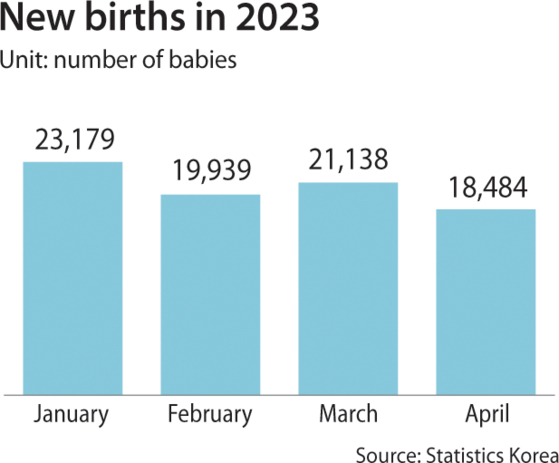Births and marriages hit April lows as declines continue
![Nurses take care of babies at a hospital in Daejeon. [KIM SEONG-TAE]](https://koreajoongangdaily.joins.com/data/photo/2023/06/28/b926a763-76c9-4ebd-b3d7-474a3772ec17.jpg)
Nurses take care of babies at a hospital in Daejeon. [KIM SEONG-TAE]
Korea suffered the steepest drop to date in the number of new births and marriages for an April, despite the month being widely favored for tying the knot.
A total of 18,484 babies were born in April, down 12.7 percent on year and the lowest April figure since the government began tracking birth data in 1981, according to Statistics Korea on Wednesday.
The country has registered monthly declines in new births for 89 consecutive months since December 2015.
On a cumulative basis, 82,740 babies were born between January and April, down 7.6 percent compared to the same period last year.

The downbeat result will likely lead to lower fertility rates than last year’s 0.78 — the average number of children born to a woman in her reproductive years — which stands as the world’s lowest.
Fewer people got married in April, further dimming prospects for the already dismal birth rate.
The number of new marriages totaled 14,475 in April, down 8.4 percent on year.
The April data put an end to the streak of monthly growth over the past eight months as people who delayed their marriage ceremony wedded after the peak of the pandemic.
“It remains to be seen whether the delayed marriages have run their course, or the reduction is transitory,” said Lim Young-il, head of the Population Census Division at Statistics Korea.
The figures are dealing a blow to the government since it has spent hundreds of billions of dollars to lift the low fertility rate.
The Presidential Committee of Aging Society and Population Policy, a presidential committee in charge of devising incentive measures to drive up birth-related rates, spent a total of 280 trillion won ($219 billion) between 2005 and 2021, but dispiriting statistics continued.
Thanks to the bounty subsidies, some districts like Gangnam now provide up to 2 million won of subsidies when residents give birth to their first child.
The number of people moving from one city to another continued to decrease in April at 497,000, down 4.9 percent from a year prior.
The relatively static movement is linked with the overall decline in property transactions and the smaller number of young people more likely to change their dwelling place.
Encircling the city of Seoul, Gyeonggi saw the highest influx of new arrivals at 4,427, while Seoul itself lost the most at 3,353 in April as more people flee to more affordable places to live.
BY PARK EUN-JEE, KIM KI-HWAN [park.eunjee@joongang.co.kr]










with the Korea JoongAng Daily
To write comments, please log in to one of the accounts.
Standards Board Policy (0/250자)